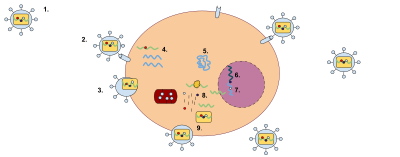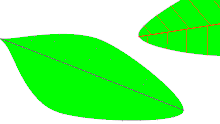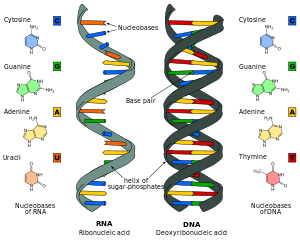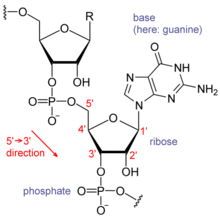| Retroviruses | |
|---|---|
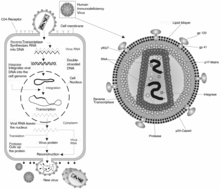
| |
| HIV retrovirus schematic of cell infection, virus production and virus structure | |
| Virus classification | |
| (unranked): | Virus |
| Phylum: | incertae sedis |
| Class: | incertae sedis |
| Order: | Ortervirales |
| Family: | Retroviridae |
| Genera | |
|
Subfamily: Orthoretrovirinae
Subfamily: Spumaretrovirinae | |
A retrovirus is a type of RNA virus that inserts a copy of its genome into the DNA of a host cell that it invades, thus changing the genome of that cell. Such viruses are specifically classified as single-stranded positive-sense RNA viruses.
Once inside the host cell's cytoplasm, the virus uses its own reverse transcriptase enzyme to produce DNA from its RNA genome, the reverse of the usual pattern, thus retro (backwards). The new DNA is then incorporated into the host cell genome by an integrase enzyme, at which point the retroviral DNA is referred to as a provirus. The host cell then treats the viral DNA as part of its own genome, transcribing and translating the viral genes along with the cell's own genes, producing the proteins required to assemble new copies of the virus. It is difficult to detect the virus until it has infected the host. At that point, the infection will persist indefinitely.
In most viruses, DNA is transcribed into RNA, and then RNA is translated into protein. However, retroviruses function differently, as their RNA is reverse-transcribed into DNA, which is integrated into the host cell's genome (when it becomes a provirus), and then undergoes the usual transcription and translational processes to express the genes carried by the virus. The information contained in a retroviral gene is thus used to generate the corresponding protein via the sequence: RNA → DNA → RNA → polypeptide. This extends the fundamental process identified by Francis Crick (one gene-one peptide) in which the sequence is DNA → RNA → peptide (proteins are made of one or more polypeptide chains; for example, haemoglobin is a four-chain peptide).
Retroviruses are valuable research tools in molecular biology, and they have been used successfully in gene delivery systems.
Structure
Virions
of retroviruses consist of enveloped particles about 100 nm in
diameter. The virions also contain two identical single-stranded RNA molecules 7–10 kilobases
in length. Although virions of different retroviruses do not have the
same morphology or biology, all the virion components are very similar.
The main virion components are:
- Envelope: composed of lipids (obtained from the host plasma membrane during the budding process) as well as glycoprotein encoded by the env gene. The retroviral envelope serves three distinct functions: protection from the extracellular environment via the lipid bilayer, enabling the retrovirus to enter/exit host cells through endosomal membrane trafficking, and the ability to directly enter cells by fusing with their membranes.
- RNA: consists of a dimer RNA. It has a cap at the 5' end and a poly(A) tail at the 3' end. The RNA genome also has terminal noncoding regions, which are important in replication, and internal regions that encode virion proteins for gene expression. The 5' end includes four regions, which are R, U5, PBS, and L. The R region is a short repeated sequence at each end of the genome used during the reverse transcription to ensure correct end-to-end transfer in the growing chain. U5, on the other hand, is a short unique sequence between R and PBS. PBS (primer binding site) consists of 18 bases complementary to 3' end of tRNA primer. L region is an untranslated leader region that gives the signal for packaging of the genome RNA. The 3' end includes 3 regions, which are PPT (polypurine tract), U3, and R. The PPT is a primer for plus-strand DNA synthesis during reverse transcription. U3 is a sequence between PPT and R, which serves as a signal that the provirus can use in transcription. R is the terminal repeated sequence at 3' end.
- Proteins: consisting of gag proteins, protease (PR), pol proteins, and env proteins.
- Group-specific antigen (gag) proteins are major components of the viral capsid, which are about 2000–4000 copies per virion.
- Protease is expressed differently in different viruses. It functions in proteolytic cleavages during virion maturation to make mature gag and pol proteins.
- Pol proteins are responsible for synthesis of viral DNA and integration into host DNA after infection.
- Env proteins play a role in association and entry of virions into the host cell. Possessing a functional copy of an env gene is what makes retroviruses distinct from retroelements. The ability of the retrovirus to bind to its target host cell using specific cell-surface receptors is given by the surface component (SU) of the Env protein, while the ability of the retrovirus to enter the cell via membrane fusion is imparted by the membrane-anchored trans-membrane component (TM). Thus it is the Env protein that enables the retrovirus to be infectious.
Multiplication
A
retrovirus has a membrane containing glycoproteins, which are able to
bind to a receptor protein on a host cell. There are two strands of RNA
within the cell that have three enzymes: protease, reverse
transcriptase, and integrase (1). The first step of replication is the
binding of the glycoprotein to the receptor protein (2). Once these have
been bound, the cell membrane degrades, becoming part of the host cell,
and the RNA strands and enzymes enter the cell (3). Within the cell,
reverse transcriptase creates a complementary strand of DNA from the
retrovirus RNA and the RNA is degraded; this strand of DNA is known as
cDNA (4). The cDNA is then replicated, and the two strands form a weak
bond and enter the nucleus (5). Once in the nucleus, the DNA is
integrated into the host cell's DNA with the help of integrase (6). This
cell can either stay dormant, or RNA may be synthesized from the DNA
and used to create the proteins for a new retrovirus (7). Ribosome units
are used to transcribe the mRNA of the virus into the amino acid
sequences which can be made into proteins in the rough endoplasmic
reticulum. This step will also make viral enzymes and capsid proteins
(8). Viral RNA will be made in the nucleus. These pieces are then
gathered together and are pinched off of the cell membrane as a new
retrovirus (9).
When retroviruses have integrated their own genome into the germ line, their genome is passed on to a following generation. These endogenous retroviruses (ERVs), contrasted with exogenous ones, now make up 5-8% of the human genome. Most insertions have no known function and are often referred to as "junk DNA".
However, many endogenous retroviruses play important roles in host
biology, such as control of gene transcription, cell fusion during placental development in the course of the germination of an embryo,
and resistance to exogenous retroviral infection. Endogenous
retroviruses have also received special attention in the research of immunology-related pathologies, such as autoimmune diseases like multiple sclerosis, although endogenous retroviruses have not yet been proven to play any causal role in this class of disease.
While transcription was classically thought to occur only from DNA to RNA, reverse transcriptase transcribes RNA into DNA. The term "retro" in retrovirus refers to this reversal (making DNA from RNA) of the central dogma of molecular biology. Reverse transcriptase activity outside of retroviruses has been found in almost all eukaryotes, enabling the generation and insertion of new copies of retrotransposons
into the host genome. These inserts are transcribed by enzymes of the
host into new RNA molecules that enter the cytosol. Next, some of these
RNA molecules are translated into viral proteins. For example, the gag gene is translated into molecules of the capsid protein, the pol gene is translated into molecules of reverse transcriptase, and the env
gene is translated into molecules of the envelope protein. It is
important to note that a retrovirus must "bring" its own reverse
transcriptase in its capsid,
otherwise it is unable to utilize the enzymes of the infected cell to
carry out the task, due to the unusual nature of producing DNA from RNA.
Industrial drugs that are designed as protease and reverse transcriptase inhibitors
are made such that they target specific sites and sequences within
their respective enzymes. However these drugs can quickly become
ineffective due to the fact that the gene sequences that code for the
protease and the reverse transcriptase quickly mutate. These changes in
bases cause specific codons and sites with the enzymes to change and
thereby avoid drug targeting by losing the sites that the drug actually
targets.
Because reverse transcription lacks the usual proofreading of DNA replication, a retrovirus mutates very often. This enables the virus to grow resistant to antiviral pharmaceuticals quickly, and impedes the development of effective vaccines and inhibitors for the retrovirus.
One difficulty faced with some retroviruses, such as the Moloney
retrovirus, involves the requirement for cells to be actively dividing
for transduction. As a result, cells such as neurons are very resistant
to infection and transduction by retroviruses. This gives rise to a
concern that insertional mutagenesis due to integration into the host
genome might lead to cancer or leukemia. This is unlike Lentivirus, a genus of Retroviridae, which are able to integrate their RNA into the genome of non-dividing host cells.
Transmission
- Cell-to-cell
- Fluids
- Airborne, like the Jaagsiekte sheep retrovirus.
Provirus
This
DNA can be incorporated into host genome as a provirus that can be
passed on to progeny cells. The retrovirus DNA is inserted at random
into the host genome. Because of this, it can be inserted into oncogenes.
In this way some retroviruses can convert normal cells into cancer
cells. Some provirus remains latent in the cell for a long period of
time before it is activated by the change in cell environment.
Early evolution
Studies
of retroviruses led to the first demonstrated synthesis of DNA from RNA
templates, a fundamental mode for transferring genetic material that
occurs in both eukaryotes and prokaryotes.
It has been speculated that the RNA to DNA transcription processes used
by retroviruses may have first caused DNA to be used as genetic
material. In this model, the RNA world hypothesis, cellular organisms adopted the more chemically stable DNA when retroviruses evolved to create DNA from the RNA templates.
An estimate of the date of evolution of the foamy-like endogenous
retroviruses placed the time of the most recent common ancestor at >
450 million years ago.
Gene therapy
Gammaretroviral and lentiviral vectors for gene therapy
have been developed that mediate stable genetic modification of treated
cells by chromosomal integration of the transferred vector genomes.
This technology is of use, not only for research purposes, but also for
clinical gene therapy aiming at the long-term correction of genetic
defects, e.g., in stem and progenitor cells. Retroviral vector particles
with tropism for various target cells have been designed.
Gammaretroviral and lentiviral vectors have so far been used in more
than 300 clinical trials, addressing treatment options for various
diseases. Retroviral mutations can be developed to make transgenic mouse models to study various cancers and their metastatic models.
Cancer
Retroviruses that cause tumor growth include Rous sarcoma virus and Mouse mammary tumor virus.
Cancer can be triggered by proto-oncogenes that were mistakenly
incorporated into proviral DNA or by the disruption of cellular
proto-oncogenes. Rous sarcoma virus contains the src gene
that triggers tumor formation. Later it was found that a similar gene
in cells is involved in cell signaling, which was most likely excised
with the proviral DNA. Nontransforming viruses can randomly insert their
DNA into proto-oncogenes, disrupting the expression of proteins that
regulate the cell cycle. The promoter of the provirus DNA can also cause
over expression of regulatory genes.
Classification
Phylogeny of Retroviruses
Exogenous
These are infectious RNA- or DNA-containing viruses which are transmitted from individual to individual.
Reverse-transcribing viruses fall into 2 groups of the Baltimore classification.
Group VI viruses
All members of Group VI use virally encoded reverse transcriptase,
an RNA-dependent DNA polymerase, to produce DNA from the initial virion
RNA genome. This DNA is often integrated into the host genome, as in
the case of retroviruses and pseudoviruses, where it is replicated and transcribed by the host.
Group VI includes:
- Order Ortervirales
- Family Belpaoviridae
- Family Metaviridae
- Family Pseudoviridae
- Family Retroviridae – Retroviruses, e.g. HIV
- Family Caulimoviridae – a VII group virus family
The family Retroviridae was previously divided into three subfamilies (Oncovirinae, Lentivirinae, and Spumavirinae), but are now divided into two: Orthoretrovirinae and Spumaretrovirinae. The term oncovirus is now commonly used to describe a cancer-causing virus. This family now includes the following genera:
- Subfamily Orthoretrovirinae:
- Genus Alpharetrovirus; type species: Avian leukosis virus; others include Rous sarcoma virus
- Genus Betaretrovirus; type species: Mouse mammary tumour virus
- Genus Gammaretrovirus; type species: Murine leukemia virus; others include Feline leukemia virus
- Genus Deltaretrovirus; type species: Bovine leukemia virus; others include the cancer-causing Human T-lymphotropic virus
- Genus Epsilonretrovirus; type species: Walleye dermal sarcoma virus
- Genus Lentivirus; type species: Human immunodeficiency virus 1; others include Simian, Feline immunodeficiency viruses
- Subfamily Spumaretrovirinae:
- Genus Bovispumavirus
- Genus Equispumavirus
- Genus Felispumavirus
- Genus Prosimiispumavirus; type species: Brown greater galago prosimian foamy virus
- Genus Simiispumavirus; type species: Eastern chimpanzee simian foamy virus
Note that according to ICTV 2017, genus Spumavirus has been divided into five genera, and its former type species Simian foamy virus is now upgraded to genus Simiispumavirus with not less than 14 species, including new type species Eastern chimpanzee simian foamy virus.
Group VII viruses
Both families in Group VII
have DNA genomes contained within the invading virus particles. The DNA
genome is transcribed into both mRNA, for use as a transcript in
protein synthesis, and pre-genomic RNA, for use as the template during
genome replication. Virally encoded reverse transcriptase uses the pre-genomic RNA as a template for the creation of genomic DNA.
Group VII includes:
- Family Caulimoviridae — e.g. Cauliflower mosaic virus
- Family Hepadnaviridae — e.g. Hepatitis B virus
The latter family is closely related to the newly proposed
- Family Nackednaviridae — e.g. African cichlid nackednavirus (ACNDV), formerly named African cichlid hepatitis B virus (ACHBV).
whilst families Belpaoviridae, Metaviridae, Pseudoviridae, Retroviridae, and Caulimoviridae constitute the order Ortervirales.
Endogenous
Endogenous retroviruses are not formally included in this
classification system, and are broadly classified into three classes, on
the basis of relatedness to exogenous genera:
- Class I are most similar to the gammaretroviruses
- Class II are most similar to the betaretroviruses and alpharetroviruses
- Class III are most similar to the spumaviruses.
Treatment
Antiretroviral drugs are medications for the treatment of infection by retroviruses, primarily HIV. Different classes of antiretroviral drugs act on different stages of the HIV life cycle.
Combination of several (typically three or four) antiretroviral drugs
is known as highly active anti-retroviral therapy (HAART).
Treatment of veterinary retroviruses
Feline leukemia virus and Feline immunodeficiency virus infections are treated with biologics, including the only immunomodulator currently licensed for sale in the United States, Lymphocyte T-Cell Immune Modulator (LTCI).
